2011 Volume Issue 2
March 30, 2011
For a downloadable version, click the following:
U.S. Balance of Payments and the Greatest Puppet Show on Earth: China; the Oil Cartel(s); and Energy and the Environment
(The Puppeteers par Excellence)
For years, critic after critic has bemoaned the U.S. Trade Deficit. Virtually everything imaginable on earth has been cited as the cause of the Trade Deficit. In turn, virtually every economic woe besetting the U.S. is said to be a result of the Trade deficit. Let’s look at the dots and join a few of them with the purpose of determining some of the culprits that are the dominant causes of the Trade Deficit – The Puppeteers, as referred to in this article.
We will begin a brief review of some basic concepts to be examined in this article but for the reader who is not familiar with the language and structure of the Balance of Payments Accounts (BOPA), we ask you to read our past newsletters where such distinctions were discussed in great detail.
U.S. Trade Deficit: Good, Bad, or Irrelevant?
October 10, 2003
www.econnewsletter.com/oct102003
HERE WE GO AGAIN: The broken CD (record) routine…before it was Japan and Germany eating our lunch, now it is China
September 23, 2010
www.econnewsletter.com/sep232010
The Laffer Curve and the J-Curve are Analytically like Two Peas in a Pod
December 2, 2010
www.econnewsletter.com/dec022010
The Trade Balance of the U.S. is equal to U.S. exports minus U.S. imports of merchandise and services. When such exports are greater than imports, it is termed a Trade Surplus. When such imports exceed exports, it is termed a Trade Deficit. Formally, the Trade Balance is called the Balance on Merchandise and Services Accounts. It is a combination of (1) the Merchandise or Goods Account and (2) the Services Account.
The third of the five accounts in the BOPA is the Unilateral Transfers Account. It includes foreign aid and private remittances of a supposedly non-quid pro quo variety. With some historic exceptions, it is usually a relatively small amount. For the U.S. in recent years, it usually has had a deficit balance, i.e., we give more officially and privately to the rest of the world than they give us.
When the Unilateral Transfer Account is combined with the Merchandise and Services Accounts, the integrated account is called the Current Account. For the U.S., the Trade Balance dominates the Current Account Balance.
The remaining two accounts in the BOPA are (4) the Long-term and (5) the Short-term Capital Accounts. Since the BOPA is a double-entry bookkeeping system, when all five accounts are included, it must balance, assuming the bookkeeping is correct. The BOPA is an all inclusive and mutually exclusive system that includes the entire international interface between one area and another.
This means that if the Current Account is manifesting a deficit of $300 billion for a period of time, i.e. a year, for the same time period the combined capital account must be manifesting a surplus of $300 billion. For the same time period, if the current account is experiencing a surplus of $300 billion, the combined capital accounts must be experiencing a deficit of $300 billion. Causality can run either way.
We argue that currently, given the preponderance of data, the Current Account Deficit is causing the Combined Capital Account surplus. In the early 1980s, for a period of time, the causality was more likely in the opposite direction.
BRING ON THE PUPPETEERS – First China
The first puppet string we will explore is where China is the Puppeteer. The U.S. is Edgar Bergen’s Mortimer Snerd, so to speak.
muppet.wikia.com/wiki/Mortimer_Snerd

HERE WE GO AGAIN
www.econnewsletter.com/sep232010
China exports goods and the U.S. exports dollars; The U.S. imports goods and China imports jobs
Now let us look at the so called Chinese miracle and the arguments of the naysayers who are counting out the U.S. of A. More than twenty years ago in 1989, the Communist government of mainland China was busy in places like Tiananmen Square battling and sometimes killing young Chinese students. Chinese youth is just like youth everywhere, if they are not kept busy, they will raise hell. If it is really jobs they want, “give them jobs”, and at reasonable wages for the time, became the Chinese government’s answer.
(The Chinese government – looking back to 1984)
Problem: Who will buy the goods thus produced??
Solution: The over-consuming Americans will, of course.
Problem: At $0.50 U.S. for one (¥) (CNY) Yuan or Renminbi, a television imported from China was too expensive even to U.S consumers.
Solution: Go into foreign exchange markets and buy Dollars and sell Yuan until the price of a Yuan fell 75% to $0.125. Peg the exchange rate there by continued intervention. Then exports from China into the U.S. would be a bargain at 75% less than previously. At that pegged rate resulting in the Yuan price of the Dollar rising from 2 to 8 Yuan, Chinese imports from the U.S. would be four times as expensive. Within 10 years, from January 1984 to January 1994, the Yuan went from $0.488 per Yuan to $0.115 per Yuan.
The China Syndrome
The first major cause of the U.S. Trade Deficit is the artificially low U.S. Dollar price of the Chinese Yuan. A few years before the riots that rocked China, culminating in the famous Tiananmen Square debacle, China realized that it had to provide opportunities for its young. Jobs would be one way, but they had to be at an acceptable level of labor compensation. Who would buy the products of their efforts? To assure foreign markets, since consumer spending in China was not sufficient to absorb the onslaught of greater domestic production, the solution for China was to intervene in the foreign exchange market and peg the Dollar price of the Yuan at about 75% below its equilibrium. It did so over a ten-year period, a financial version of “death by a thousand cuts.” At the time when this policy was instituted, the exchange rate was about $0.50 for 1 Chinese Yuan. The peg was established at $0.125 for 1 Yuan.
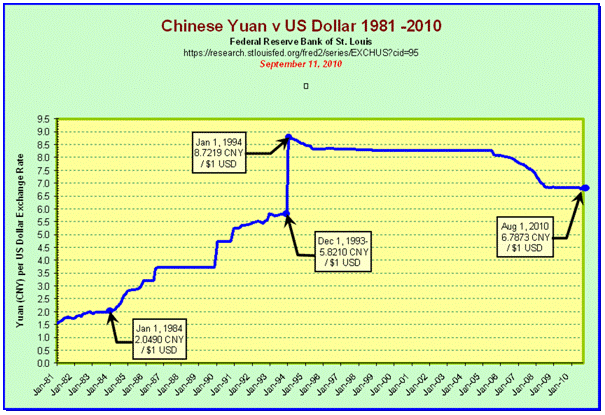
Recall that in international trade there are two prices, in this case the Yuan price of the Chinese good to be imported in to the U.S. and the dollar price of the Chinese Yuan, usually referred to as the exchange rate. This meant that a TV set costing 1000 Yuan fell from a dollar price of $500 to $125 or a discount of 75%. This also meant that the Chinese price of imports from the U.S. rose considerably. Before the pegging occurred, the Yuan price of the Dollar was 2 Yuan (per $1 USD) and after the peg was established, the Yuan price of the U.S. Dollar rose to 8 (per $1 USD) or about a 300% increase. This had a considerable negative impact on U.S. exports to China.
Within this period of time the U.S. Trade Balance with China went from $6 million deficit in 1985 to $6 billion deficit by 1989.
The exchange rate as of March 24, 2011 is 6.56 (¥) (CNY) Yuan or Renminbi per $1 USD. This reflects about a 20% depreciation of the dollar against the Yuan, which is the same as saying the Yuan appreciated with respect to the dollar over the last year or so.

Do you know that our Trade Deficit with China comprises more than 50% percent of our total Trade Deficit?
Note the steady increase of the U.S. Trade deficit with China as a percent of the total U.S. Trade deficit from 2000 to 2010 in the following two pie charts. It has risen from 22% in 2000 to 54% in 2010.
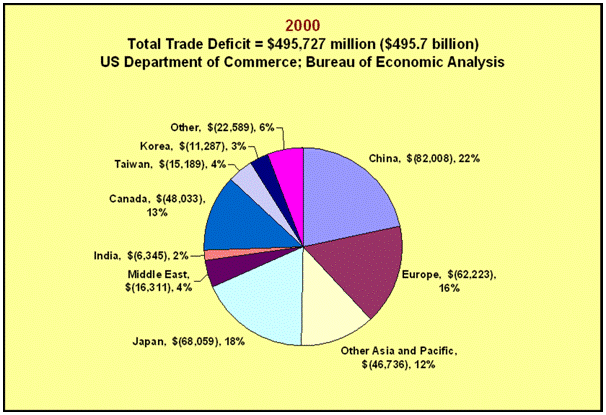


THE SECOND PUPPETEER, THE EXPANDED OIL CARTEL
‘It’s the market…we have no control over prices’
The newly cartelized U.S. oil firms have trumpeted this lament over the past several years.
The second major cause of the U.S. Trade Deficit is the large volume of petroleum imports at prices established by the oil cartel, OPEC and its fellow travelers, the U.S. branch cartelized in the period from the 1993 to 2003.
(The Energy Challenge: U.S. Oil Industry (Merger-Mania) and the FED Conundrum Continues)
May 31, 2005
www.econnewsletter.com/may312005
- 1997 Ashland Oil combines most assets with Marathon Oil
- 1998 British Petroleum (BP) acquires Amoco
- 1998 Pennzoil merges with Quaker State Oil
- 1999 Exxon and Mobil join to form Exxon Mobil
- 2000 British Petroleum (BP) acquires ARCO (Atlantic Richfield)
- 2001 Chevron acquires Texaco to form Chevron Texaco
- 2002 Conoco merges with Phillips
- 2002 Royal Dutch Shell acquires Pennzoil-Quaker State
When the Seven Sisters determined oil production levels and hence the per barrel price of oil exported from primarily the Middle East, i.e., prior to 1973, the per barrel price of crude was about $3.50. When the Middle East power brokers led by Saudi Arabia took control, they forced the Seven Sisters to reduce production and set the price at $14 per barrel, a 300% increase. This caused both inflation and a recession like slowing of the U.S. economy. Many of our younger readers did not live through this ordeal. As inflation occurred peaking at an annual rate of nearly 20% around late 1979 and early 1980, the FED slammed on its brake and engineered a recession to eliminate much of the inflation by mid-1982. The per barrel price of oil from OPEC nations continued to rise to around $19 per barrel in 1978 when OPEC once again cut production and caused the price of crude oil to rise by 100% to $38 per barrel.
The next really major event occurred over a nearly ten year period from around 1993 to 2003 when the U.S. oil industry recartelized. Recall that the Rockefeller oil cartel, Standard Oil Trust, was legally disbanded by a court decision around the beginning of the 20th Century, although a number of historians doubt that the court decision had any significant and lasting effect. Nearly a century later, the anti trust authorities, the Anti-Trust Division of the U.S. Department of Justice and the Federal Trade Commission, our “sworn protectors” against the evils of anti-competitive activities, refused to stop the recartelization of the American branch of the oil industry. As cited earlier, 13 of the largest oil companies merged into 5 including the merger of Exxon and Mobil, two of the world’s largest oil companies.
In 2004 OPEC (Organization of the Petroleum Exporting Countries) and OPIC (our acronym for domestic big oil – Organization of the Petroleum Importing Countries) struck again and raised their per barrel price from $35 and along with massive speculation in oil futures fostered by the same investment bankers that gave us (MBS) mortgage backed securities (CDOs, CDSs, etc.) and the financial chaos surfacing in 2008, the per barrel price rose to $145 in the June/July 2008.
With the ensuing recession, oil prices fell back to around the $40 range only to rise back up well above the $100 per barrel range.
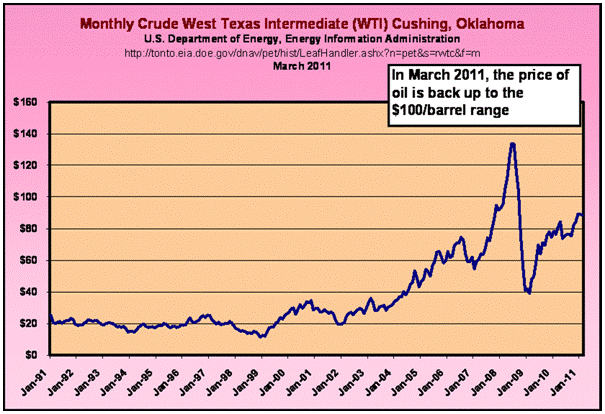
The American oil companies, fresh from their recartelization activities, ‘went along with the market’ and also raised their prices. Translating, they had informally joined OPEC. As we have argued on this website, this was part of the beginning of the ongoing recession in the U.S. and the agony of high unemployment rates with its effects including foreclosures, inflation by decontenting, etc.
INFLATION BY DECONTENTING: Less roll for your buck?
February 12, 2011
www.econnewsletter.com/feb122011
THE THIRD PUPPETEER, THE ENVIRONMENTALISTS
A major cause of the huge imports of oil into the U.S. has been the successful campaign of the environmentalists to reduce the use of fossil fuels produced in the U.S. Assumed answers, rather than asked questions, are the hall mark of this movement. How is it that we somehow equate importing expensive oil over vast distances from less than stable or desirable sources as preferable to exploiting our own reserves? This seems to defy reason. The U.S. has huge coal reserves and growing oil and gas reserves as improvements in technology have overcome the former inability of releasing oil and natural gas from shale.
Do you know that our net energy imports constituted more than 70% of our total trade deficit in 2010?

If we could eliminate the trade deficit with China and eliminate imported petroleum products, OUR TRADE DEFICIT WOULD BE CONVERTED IN TO A SIGNIFICANT TRADE SURPLUS !!!!
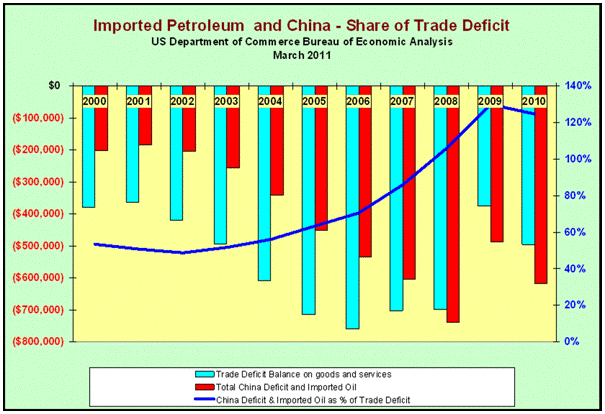

Macroeconomic theory tells us that since imports depress domestic aggregate demand and exports increase the aggregate demand of our economy, trade deficits reduce aggregate demand of the U.S. economy and therefore depress the level of economic activity aggravating an already hefty U-6 unemployment rate of nearly 16%
Employment Situation
February 2011
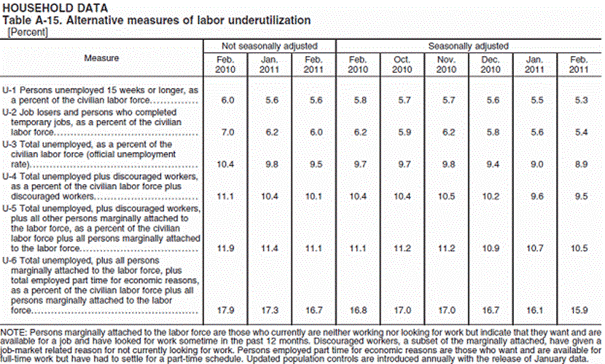
Did you know that the U.S. has enormous coal reserves economically exploitable with current technology?
Based on U.S. coal consumption for 2008, the U.S. recoverable coal reserves represent enough coal to last 234 years. However, EIA projects in [their] most recent Annual Energy Outlook (April 2009) that U.S. coal consumption will increase at about 0.6% per year for the period 2007-2030. If that growth rate continues into the future, U.S. recoverable coal reserves would be exhausted in about 146 years if no new reserves are added.
www.eia.doe.gov/energyexplained/index.coal_reserves
Did you know that the U.S. has over one-hundred years of reserves of natural gas?
According to the EIA Annual Energy Outlook 2011, the United States possesses 2,552 trillion cubic feet (Tcf) of potential natural gas resources. Natural gas from shale resources, considered uneconomical just a few years ago, accounts for 827 Tcf of this resource estimate, more than double the estimate published last year. At the 2009 rate of U.S. consumption (about 22.8 Tcf per year), 2,552 Tcf of natural gas is enough to supply approximately 110 years of use.
www.eia.doe.gov/energyexplained/index.natural_gas_reserves
Advances in drilling called hydraulic fracturing or ‘fracking’ have been significantly EXPANDING our proven currently exploitable reserves of natural gas and oil. Massive fields such as Marcellus in the Appalachians and Barnett (North Texas) and Haynesville (NW Louisiana and East Texas), are already adding to the supply of energy, DOMESTICALLY SUPPLIED. The evidence overwhelmingly shows that no environmental harm exists from ‘fracking’ techniques.
Hydraulic Fracturing (fracking)
U.S. EPA
water.epa.gov/type/groundwater/hydraulicfracturing
Oklahoma Oil and Gas Execs Concerned About EPA's 'Fracking' Study
"The facts are," Anthony said in a written statement, "that hydraulic fracturing has been used in Oklahoma about 100,000 times in the last 60 years, with no documented cases of groundwater contamination."
Despite the bungling by British Petroleum of deep drilling in the Caribbean and Gulf of Mexico, safe technologies have already been developed to exploit the massive reserves of petroleum products in these areas.
ENERGY, ENERGY, EVERYWHERE – BUT WHY DOES IT COST SO MUCH?
www.econnewsletter.com/feb212007
Minerals Management Service (US Department of The Interior)
www.mms.gov/ooc/press/2006/press1010.htm
Wind Power in the U.S.
en.wikipedia.org/wiki/Wind_power_in_the_United_States
At the end of 2010, the installed capacity of wind power in the United States was just over 40,000 megawatts (MW)…Wind power accounts for about 3% of the electricity generated in the United States.
A study by Michigan State University argued that enough wind power could be achieved from on and off shore Lake Michigan windmills to satisfy nearly one-quarter of the nation’s need for electricity ON A RENEWABLE BASIS.
Michigan's Offshore Wind Potential - Land Policy Institute
www.landpolicy.msu.edu/modules.php?name=Documents
Assuming that wind towers can be located at all depths without restrictions, Michigan could potentially generate 321,936 Megawatts (Mw) of electricity from offshore wind.
A portion of royalties or severance taxes from the domestic exploitation of fossil fuels could be directed toward a scientifically framed agenda for the reduction of polluting side effects of using fossil fuels to generate energy and would give us a much more sane energy policy than the mish-mash of policies from which we are currently suffering.
REDUCING TERRIOSM
The funding for most of the terrorist activities that have beset the U.S. and other parts of the world has ultimately come from terrorists organizations funded by oil revenues from nations like Saudi Arabia and Iran. On the one hand we send our military into areas on the grounds of humanitarianism and at the same time we also send dollars from oil purchases from OPEC nations to enable terrorist organizations to buy weapons to maim and kill those same military personnel. Denying the use of domestic energy sources and making this nation rely on imported petroleum is sheer hypocrisy at best and lunacy at worst.
Let’s stop being puppets, manipulated by other nations and dubious groups under the collective term environmentalists.
As Patrick Henry challenged his fellow delegates in the Second Virginia Convention of March 23, 1775 in St. John’s Church:
The war is actually begun! The next gale that sweeps from the north will bring to our ears the clash of resounding arms! Our brethren are already in the field! Why stand we here idle? What is it that gentlemen wish? What would they have? Is life so dear, or peace so sweet, as to be purchased at the price of chains and slavery? Forbid it, Almighty God! I know not what course others may take; but as for me, give me liberty or give me death!


